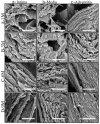Matrix Regeneration Ability In Situ Induced by a Silk Fibroin Small-Caliber Artificial Blood Vessel In Vivo
- PMID: 36145899
- PMCID: PMC9502482
- DOI: 10.3390/polym14183754
Matrix Regeneration Ability In Situ Induced by a Silk Fibroin Small-Caliber Artificial Blood Vessel In Vivo
Abstract
The success of a small-caliber artificial vascular graft in the host in order to obtain functional tissue regeneration and remodeling remains a great challenge in clinical application. In our previous work, a silk-based, small-caliber tubular scaffold (SFTS) showed excellent mechanical properties, long-term patency and rapid endothelialization capabilities. On this basis, the aim of the present study was to evaluate the vascular reconstruction process after implantation to replace the common carotid artery in rabbits. The new tissue on both sides of the SFTSs at 1 month was clearly observed. Inside the SFTSs, the extracellular matrix (ECM) was deposited on the pore wall at 1 month and continued to increase during the follow-up period. The self-assembled collagen fibers and elastic fibers were clearly visible in a circumferential arrangement at 6 months and were similar to autologous blood vessels. The positive expression rate of Lysyl oxidase-1 (LOXL-1) was positively correlated with the formation and maturity of collagen fibers and elastic fibers. In summary, the findings of the tissue regeneration processes indicated that the bionic SFTSs induced in situ angiogenesis in defects.
Keywords: ECM; matrix fiber self-assembly; silk fibroin; small-caliber artificial vessels.
Conflict of interest statement
The authors declare no conflict of interest.
Figures








References
-
- Catto V., Fare S., Cattaneo I., Figliuzzi M., Alessandrino A., Freddi G., Remuzzi A., Tanzi M.C. Small diameter electrospun silk fibroin vascular grafts: Mechanical properties, in vitro biodegradability, and in vivo biocompatibility. Mater. Sci. Eng. C. 2015;54:101–111. doi: 10.1016/j.msec.2015.05.003. - DOI - PubMed
-
- Cabrera P.O. Esthetic root coverage in periodontics: A review. CDS Rev. 1995;88:30–34. - PubMed
Grants and funding
LinkOut - more resources
Full Text Sources
Other Literature Sources

